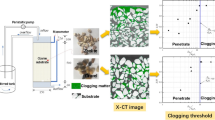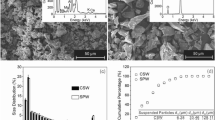Abstract
The clogging problem caused by the migration of suspended particles in in situ leaching of uranium has become an important factor restricting production efficiency. However, research on the laws and mechanisms related to physical clogging in this field has not yet been reported. This study established a simulation experimental system for the migration and clogging of suspended particles in porous media, and studied the clogging laws of suspended particles with different particle sizes and the ratio of pore diameter to suspended particle size o/d in porous media. The results show that under the conditions of a suspended particles concentration of 200 mg/L and a suspension flow velocity of 9 mL/min, when o/d ≥ 11.4, only a small amount of internal deposition of suspended particles occurs in porous media; When 2.8 < o/d < 11.4, the suspended particles in the porous medium are mainly characterized by internal deposition and internal pore clogging; When o/d ≤ 2.8, surface clogging will occur in the porous medium, and in severe cases, "mud cake" phenomenon will occur. The dimensionless parameter Reynolds number is introduced to identify the critical state of clogging by correlating the ratio of pore diameter to suspended particle size suspension velocity and suspended particle concentration through an exponential law model. The research results have laid the foundation for further research on alleviating the clogging problem caused by suspended particles in the in situ leaching process of uranium.







Similar content being viewed by others
References
Yousif O, Karakouzian M et al (2017) Physical clogging of uniformly graded porous media under constant flow rates. Transport Porous Media 120(3):643–659
Ding L, Shi B, Lv X et al (2017) Hydrate formation and plugging mechanisms in different gas-liquid flow patterns[J]. Ind Eng Chem Res 56(14):4173–4184
Liu Y, Sun W, Du B et al (2018) The physical clogging of the landfill leachate collection system in China: based on filtration test and numerical modelling[J]. Int J Environ Res Public Health 15(2):318
Ho C, Zydney A (2000) A combined pore blockage and cake filtration model for protein fouling during microfiltration [J]. J Colloid Interface 232(2):389–399
Gerber G, Stéphane R, Aimedieu P, et al. (2018) Particle-size-exclusion clogging regimes in porous media[J]. Phys Rev Lett, 120(14).
Jialing C, Jiahui F, Jinhu W et al (2021) (2021) Progress of in situ leaching of uranium for descaling and plugging[J]. Yunnan Chem Technol 1:4
Zhou C, Wang H et al (2023) Simulation study on clogging of suspended particles in in situ leaching of uranium at different concentrations and flow velocity[J]. Physicochem Prob Mineral Process 59(2):162150
Bai B, Xu T, Guo Z (2016) An experimental and theoretical study of the seepage migration of suspended particles with different sizes [J]. Hydrogeol J 24(8):2063–2078
Chen C, Liu K, Shang J (2017) Effects of ionic strength, electrolyte type, pH, and flow rate on transport and retention of atmospheric deposition particles in saturated porous media [J]. J Soils Sediments 18(3):1066–1075
Dressaire E, Sauret A (2016) Clogging of microfluidic systems [J]. Soft Matter 13(1):37–48
Du X, Zhang H, Ye X, et al. (2018) Flow velocity effects on Fe (III) clogging during managed aquifer recharge using urban storm water [J]. Water, 10(4):
Feia S, Dupla JC, Ghabezloo S et al (2015) Experimental investigation of particle suspension injection and permeability impairment in porous media [J]. Geomech Energy Environ 3:24–39
He J, Wang D, Zhou D (2019) Transport and retention of silver nanoparticles in soil: effects of input concentration, particle size and surface coating [J]. Sci Total Environ 648:102–108
Hou J, Xu X, Lan L et al (2020) Transport behavior of micro polyethylene particles in saturated quartz sand: impacts of input concentration and physicochemical factors [J]. Environ Pollut 263:114499
Agbangla GC, Climent É, Bacchin P (2012) Experimental investigation of pore clogging by microparticles: evidence for a critical flux density of particle yielding arches and deposits [J]. Sep Purif Technol 101:42–48
Pan J, Wang MZ, Jiang MC (2013) The effect of porous medium particle size on groundwater recharge clogging [J]. Adv Mater Res 765–767:2934–2937
Banihashem S, Karrabi M. (2020) Investigation of suspended particle size effects on clogging of soil filters under laminar flow [J]. Euro J Environ Civil Eng, 1–10.
Siriwardene NR, Deletic A, Fletcher TD (2007) Clogging of stormwater gravel infiltration systems and filters: insights from a laboratory study [J]. Water Res 41(7):1433–1440
Sakthivadivel R, Einstein HA (1970) Clogging of porous column of spheres by sediment[J]. Am Soc Civil Eng 96(2):461–472
Tang Y, Yao X, Chen Y, et al. (2020) Experiment research on physical clogging mechanism in the porous media and its impact on permeability [J]. Granular Matter, 22(2)
Du X, Ye X, Zhang X (2018) Clogging of saturated porous media by silt-sized suspended solids under varying physical conditions during managed aquifer recharge [J]. Hydrol Process 32(14):2254–2262
Muecke TW (1979) Formation fines and factors controlling their movement in porous media[J]. J Petrol Technol 31(02):144–150
Bigno Y, Oyeneyin MB, Peden JM (1994) Investigation of pore-blocking mechanism in gravel packs in the management and control of fines migration[J]. Proceedings of the Spe International Symposium for Damage Control Society of Petroleum Engineers.
Oyeneyin MB, Peden JM et al. (1995) Factors to consider in the effective managment and control of fines migration in high permeability sands[J]. Soc Pet Eng.
Khilar KC, Fogler HS (1998). Migration of fines in porous media[M]. Kluwer Academic Publishers.
Oort EV, Velzen JFG, Leerlooijer K (1993) Impairment by Suspended Solids Invasion: testing and Prediction[J]. SPE Prod Facil 8(03):178–184
Wang Z, Du X, Yang Y et al (2012) Surface clogging process modeling of suspended solids during urban stormwater aquifer recharge[J]. J Environ Sci 24(8):7
Pandya, V.B., Bhuniya, S., Khilar, C. (1998) Existence of a critical particle concentration in plugging of a packed bed[J]. AIChE J, 44(4).
Jung J, Cao SC, Shin Y-H et al (2017) A microfluidic pore model to study the migration of fine particles in single-phase and multi-phase flows in porous media [J]. Microsyst Technol 24(2):1071–1080
Shang D, Geissler B, Mew M et al (2021) Unconventional uranium in China’s phosphate rock: review and outlook[J]. Renew Sustain Energy Rev 140:110740
Pastukhov AM, Rychkov VN, Smirnov AL et al (2014) Purification of in situ leaching solution for uranium mining by removing solids from suspension[J]. Miner Eng 55:1–4
Ye X, Du X, Li S et al (2010) Study on clogging mechanism and control methods of artificial recharge [M]. Int Conf Chall Environ Sci Comput Eng 2010:29–32
Gao S, Liao W et al (2022) Application of particle counter in in situ leaching and mining of uranium [J]. Uranium Min Metall 002:041
Glover PWJ, Walker E (2009) Grain-size to effective pore-size transformation derived from electrokinetic theory [J]. Geophysics 74(1):17–29
Valdes JR (2002) Fines migration and formation damage-microscale studies[D]. Georgia institute of technology.
Henry C, Minier JP, Lefevre G (2012) Towards a description of particulate fouling: from single particle deposition to clogging [J]. Adv Colloid Interface Sci, 185–186, 34–76.
Mcdowell-boyer LM, Hunt JR, Sitar N (1986) Particle transport through porous media[J]. Water Resour Res 22(13):1901–1921
Liu Q, Cui et al. (2016) Experimental investigation of suspended particles transport through porous media: particle and grain size effect[J]. Environ Technol.
Iscan AG, Civan F (2006) Correlation of criteria for perforation and pore clogging by particles [J]. J Porous Media 9(6):541–558
Civan F (2015) Modified formulations of particle deposition and removal kinetics in saturated porous media [J]. Transp Porous Media 111(2):381–410
Civan F (2007) Reservoir formation damage, burlington. Gulf Professional Publishing, Massachusetts
Dressaire E, Sauret A (2017) Clogging of microfluidic systems. Soft Matter 13:37–48
Acknowledgements
This work was supported by the following funding agencies: The National Natural Science Foundation of China (11675072), The Hunan Provincial Innovation Foundation for Postgraduate (QL20220207).
Author information
Authors and Affiliations
Contributions
CZ: Conceptualization, Investigation, Methodology, Data curation, Writing—original draft, Funding acquisition. HW: Writing—review & editing. TW: Data curation. EH: Validation, Supervision. ZL: Validation, Supervision. Qingliang Wang: Supervision, Funding acquisition.
Corresponding author
Ethics declarations
Conflict of interest
The authors declare that they have no known competing financial interests or personal relationships that could have appeared to influence the work reported in this paper.
Additional information
Publisher's Note
Springer Nature remains neutral with regard to jurisdictional claims in published maps and institutional affiliations.
Rights and permissions
Springer Nature or its licensor (e.g. a society or other partner) holds exclusive rights to this article under a publishing agreement with the author(s) or other rightsholder(s); author self-archiving of the accepted manuscript version of this article is solely governed by the terms of such publishing agreement and applicable law.
About this article
Cite this article
Zhou, C., Wang, H., Wu, T. et al. Study on the clogging of suspended particles with different particle sizes in porous media in in situ leaching of uranium. J Radioanal Nucl Chem 332, 4243–4253 (2023). https://doi.org/10.1007/s10967-023-09112-y
Received:
Accepted:
Published:
Issue Date:
DOI: https://doi.org/10.1007/s10967-023-09112-y




